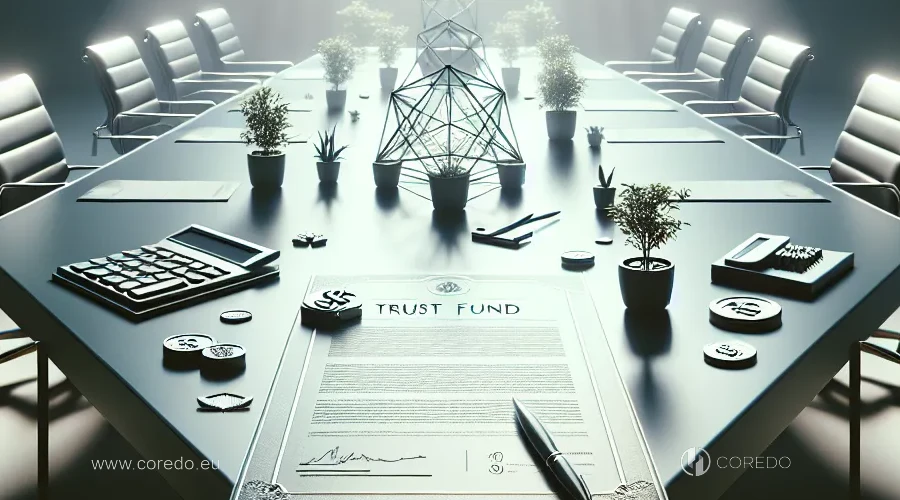
Nikita Veremeev
22.08.2025 | 6 min read
Updated: 22.08.2025
In 2024, according to STEP and Deloitte, more than 70% of international holding structures in Europe and Asia use
Trust Funds for asset protection, capital management, and tax optimization. However, despite their popularity, only a few entrepreneurs and financial directors truly understand how a trust structure works, what functions a trust fund performs, and why this tool is becoming key to sustainable business and family capital development in the face of growing regulatory and compliance requirements.
What challenges do company owners face in the EU, Asia, and Africa?
How to ensure asset protection from corporate disputes, creditors, and political risks? How to structure estate planning and optimize taxation without violating international AML and KYC standards?
The answers to these questions lie in the competent use of trust funds: a tool capable of not only preserving but also increasing capital, ensuring confidentiality and management flexibility.
In this article, I, Nikita Veremeev, founder of
COREDO, share a practical guide to creating, structuring, and functioning of a trust fund. Based on the many years of experience of the COREDO team in registering legal entities, obtaining financial licenses, and supporting international projects, we will discuss the key aspects of trust structures, their advantages, risks, and best practices in various jurisdictions. If you want to not just understand what a trust is but learn how to use it for strategic business development – this article is for you.
Trust Fund: Explained Simply

A trust fund (or fiduciary fund, trust) is a legal arrangement in which assets are transferred from the trust’s settlor to a trustee for management in the interest of one or more beneficiaries. Unlike traditional corporate structures, a trust is not a legal entity but operates under a trust deed that defines the rights, responsibilities, and asset distribution procedures.
A trust structure includes three compulsory elements: the settlor, the trustee, and the beneficiary. In some cases, a trust protector is added, an independent person controlling the trustee’s actions. This approach allows flexible asset distribution, protection from external risks, and ensures long-term succession planning.
The trust deed is a key document that records asset transfer, management, and distribution conditions. At COREDO, special attention is paid to the legal clarity and structure of this document, as it determines the trust structure’s resilience to external challenges and compliance checks.
Who are the settlor, beneficiary, and trustee?
The settlor of a trust is the person initiating the trust creation and transferring assets into fiduciary management. In international practice, the settlor can be either an individual or a legal entity, allowing trust funds to be used for corporate, family, and charitable purposes.
The beneficiary of a trust is the ultimate beneficiary on whose behalf trust management is conducted. Beneficial ownership can be either direct or discretionary, where the trustee independently determines the size and timing of asset distribution.
The trustee is a professional participant with fiduciary responsibility for managing assets strictly according to the trust deed and the jurisdiction’s legislation. In complex structures, a trust protector is appointed with the right to control and replace the trustee, increasing protection for the settlor’s and beneficiaries’ interests.
How does a trust fund work?
The trust structure is built on the principle of separating legal title and economic benefit: assets legally belong to the trustee, but economic benefit belongs to the beneficiaries. This mechanism protects assets from the settlor’s creditors, corporate disputes, and external claims.
In COREDO’s practice, multilayered management trust structures are often implemented, where the trust protector provides additional control, and asset distribution occurs according to pre-agreed scenarios. This is especially relevant for international holdings, family offices, and projects with high regulatory risks.
Trust Fund: Functions and Advantages

A trust fund performs several key functions that make it an indispensable tool for businesses and private clients:
- Asset protection through a trust: assets transferred into a trust are removed from the settlor’s ownership and become inaccessible to creditors, lawsuits, and corporate conflicts.
- Succession planning with a trust: a trust allows for the predetermined distribution of assets among heirs, minimizing dispute risks and tax losses.
- Tax optimization with a trust: a well-crafted trust structure can significantly reduce the tax burden by utilizing preferential regimes and international tax planning.
- Confidentiality and management flexibility: trust funds provide a high level of privacy for beneficiaries and allow quick responses to changes in legislation and market conditions.
Trust and inheritance: how to protect assets
In one of COREDO’s cases, when structuring a family trust fund in Singapore for the owner of a technology company, it was possible to protect assets from claims by former partners and optimize capital transfer to the next generation without lengthy legal procedures. This approach is especially in demand in jurisdictions with high levels of corporate and political risks.
Tax optimization and data protection
Trust funds in Luxembourg and Malta allow the use of tax optimization mechanisms while maintaining beneficiary confidentiality. In some jurisdictions, for example, in Singapore and the UAE, information disclosure about beneficiaries is limited only to AML and KYC requirements, ensuring a balance between transparency and privacy.
COREDO’s practice confirms that a properly structured trust deed minimizes tax risks and ensures compliance with international disclosure standards.
Thus, creating trust structures requires deep understanding of asset management and control mechanisms, especially important when using corporate trusts.
Corporate trusts: what are they and how do they work?
Corporate trust: an effective tool for managing holdings, investment portfolios, and M&A projects. In one of COREDO’s projects, during the restructuring of an international holding with assets in the EU and Asia, a trust structure was implemented to centralize management, reduce operating costs, and increase investment appeal for new partners.
Types of Trust Funds in the EU, Asia, and Africa

Registering a trust fund is possible in most developed jurisdictions. However, the requirements for structure, taxation, and information disclosure significantly differ.
Family, corporate, or charitable trust – differences
- A family trust fund is used for managing family capital, estate planning, and protecting assets from creditors.
- A corporate trust is applied for optimizing business ownership structure, managing investments, and conducting M&A deals.
- A charitable trust is intended for funding social, educational, and cultural projects, as well as implementing corporate social responsibility (CSR).
In COREDO’s practice, family and corporate trusts are often integrated with family office and private banking, ensuring comprehensive capital management and long-term development strategy.
How to choose a jurisdiction for a trust?
| Jurisdiction |
Taxation |
Disclosure Requirements |
Maintenance Cost |
Asset Protection Level |
| Luxembourg |
Preferential regime |
Moderate |
High |
Very high |
| Malta |
Moderate |
Average |
Medium |
High |
| Singapore |
Preferential |
Minimum |
Medium |
High |
| UAE |
None |
Very low |
High |
Maximum |
| Mauritius |
Preferential |
Low |
Low |
Medium |
| Seychelles |
Preferential |
Minimal |
Low |
Medium |
When choosing a trust jurisdiction, the COREDO team analyzes not only tax rates but also compliance requirements, asset protection levels, and legal support costs.
Trust Fund Registration – Support

Creating a trust fund is a multistage process requiring a deep understanding of local and international law, as well as modern AML and KYC requirements.
How to create a trust fund: step by step
- Goal and task analysis: determining the trust’s objectives (asset protection, estate planning, investments).
- Jurisdiction selection: assessment of tax, legal, and compliance risks.
- Trust deed development: drafting a detailed agreement taking into account asset distribution features and beneficiaries’ rights.
- Appointment of trustee and protector: selection of professional participants with impeccable reputations.
- Registration of the trust: submitting documents to the registering authority, passing Due Diligence and KYC procedures.
- Opening bank accounts and integration with other structures: ensuring the trust’s operational activities.
In one of COREDO’s cases, when creating a trust in Asia for an international startup, a phased approach was implemented, including preliminary asset audit, development of a multilayered trust structure, and integration with a family office.
Thus, special attention is paid to compliance and KYC requirements at every stage of trust creation and operation, which becomes a key element of subsequent structure management.
Compliance and KYC for trust structures
Modern jurisdictions have strict
compliance requirements, including mandatory beneficiary information disclosure, KYC implementation, and regular AML standard compliance checks. The EU and Asia have unified beneficiary registers, and in some countries (e.g., Malta and Luxembourg), due diligence procedures are mandatory for all trust participants.
The solution developed at COREDO provides for the implementation of automated compliance systems and the digitalization of KYC processes, allowing operational risks to be reduced and trust fund registration for international companies to be accelerated.
Costs and mistakes in creating a trust
The cost of trust maintenance consists of legal support expenses, trustee services, audit, and compliance. On average, according to PwC and EY, annual costs range from 0.5% to 2% of asset value, depending on the jurisdiction and structure complexity.
The most common mistakes faced by the COREDO team when supporting clients:
- Underestimating beneficiary information disclosure requirements;
- Choosing an unsuitable jurisdiction without considering asset specifics;
- Errors in trust deed formulations, leading to disputes between participants;
- Ignoring modern AML and KYC requirements.
Trust Fund Risks for Entrepreneurs

Despite the obvious advantages, trust funds carry certain risks and limitations that must be considered during their creation and management.
Transparency and Beneficiary Disclosure
In recent years, international regulators have strengthened transparency requirements for trust structures. In the EU, the AMLD5 Directive obliges the disclosure of beneficiary information in special registers. In Asia and Africa, requirements range from minimal to very strict, depending on the jurisdiction.
COREDO’s practice shows: to minimize risks, it is important to prepare a complete set of documents in advance and ensure all trust participants comply with compliance requirements.
Legal and Tax Risks Abroad
Key legal risks are associated with the possibility of challenging asset transfer into a trust, particularly in bankruptcy or legal disputes. Tax risks include the possibility of double taxation and improper use of preferential regimes.
In one of COREDO’s cases, when creating a trust for an international holding in Luxembourg, a comprehensive audit of tax consequences was conducted, allowing for the avoidance of tax authority claims and ensuring the long-term stability of the structure.
This is especially relevant when considering practical issues of using a trust in business.
Trust Fund for Business: How to Use?
Effective use of a trust fund requires not only sound legal work but also a strategic approach to management and integration with other tools.
Criteria for Selecting a Manager
The trustee is a key figure in a trust structure.
Selection criteria for a trustee include:
- Impeccable business reputation and experience in the chosen jurisdiction;
- Possession of a license and compliance with regulatory requirements;
- Flexibility in management and readiness to implement modern technologies;
- Transparency and readiness for regular audits.
The COREDO team recommends careful due diligence when selecting a trustee, using both international ratings and independent audits.
Integration of Trust Fund with Capital
Trust funds effectively integrate with family offices, private banking, investment portfolios, and corporate structures. This approach centralizes capital management, increases financial planning efficiency, and ensures asset management continuity.
In one of COREDO’s projects for a family office in Singapore, a trust structure was integrated with an investment portfolio and a private banking system, ensuring maximum flexibility and protecting beneficiaries’ interests.
Modern Technologies for Trust Management
Modern technologies are an integral part of efficient trust fund management. Automation of due diligence, digital platforms for compliance, and online asset management reduce costs and improve transparency.
Solutions implemented by COREDO include using specialized programs for transaction monitoring, KYC procedure automation, and corporate documentation management, which are especially important for international companies with high regulatory requirements.
Practical Steps for Entrepreneurs
A trust fund is a powerful tool for asset protection, estate and tax planning, business structure management, and enhancing investment attractiveness. However, its effectiveness depends on proper jurisdiction selection, competent legal support, and adherence to modern compliance requirements.
Checklist for choosing a trust structure:
- Clearly define the trust’s objectives (asset protection, estate planning, investments).
- Analyze tax and legal risks in potential jurisdictions.
- Prepare a detailed trust deed considering all asset distribution scenarios.
- Conduct due diligence and select a professional trustee with an impeccable reputation.
- Ensure compliance with AML, KYC, and beneficiary information disclosure requirements.
- Integrate the trust structure with other capital management tools.
- Use modern technologies for compliance automation and asset management.
The COREDO team is ready to offer comprehensive solutions for registering, supporting, and managing trust funds in the EU, Asia, and Africa, leveraging deep practical experience and knowledge of international standards. If you are looking for a reliable partner for strategic business development and capital protection, contact us for a consultation to receive an individual solution that matches your goals and objectives.




